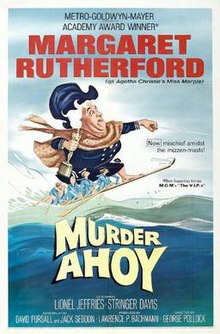This article has multiple issues. Please help improve it or discuss these issues on the talk page. (Learn how and when to remove these messages)
|
| Murder Ahoy! | |
|---|---|
 Theatrical release poster by Tom Jung | |
| Directed by | George Pollock |
| Written by | Agatha Christie (motifs) |
| Screenplay by | David Pursall Jack Seddon |
| Starring | Margaret Rutherford Lionel Jeffries Stringer Davis |
| Cinematography | Desmond Dickinson |
| Edited by | Ernest Walter |
| Music by | Ron Goodwin |
| Distributed by | Metro-Goldwyn-Mayer |
Release dates |
|
Running time | 93 minutes |
| Country | United Kingdom |
| Language | English |
Murder Ahoy! is the last of four Miss Marple films made by Metro-Goldwyn-Mayer that starred Margaret Rutherford. As in the previous three, Murder, She Said (1961), Murder at the Gallop (1963), Murder Most Foul (1964), the actress plays Agatha Christie's amateur sleuth Miss Jane Marple, with Charles 'Bud' Tingwell as (Chief) Inspector Craddock and Stringer Davis (Rutherford's husband) playing Mr. Stringer.
The film was made in 1964 and directed by George Pollock, with David Pursall and Jack Seddon credited with the script. The music was by Ron Goodwin. Location shots included Denham Village and St Mawes, Cornwall.[1]
Unlike the previous three films that were adapted from Christie novels – The 4.50 from Paddington (Murder, She Said – the only Miss Marple novel used), After the Funeral (a Poirot mystery, adapted for Miss Marple with the title Murder at the Gallop) and Mrs. McGinty's Dead (another Poirot novel, adapted as Murder Most Foul) – this film used an original screenplay that was not based on any of Christie's stories.
It does, however, employ elements of the 1952 Miss Marple story They Do It With Mirrors. Specifically, the Battledore is a training ship for teenage boys with criminal tendencies, who are supposedly being set on the straight and narrow path – when, in fact, one of the members of the crew is training them for careers in housebreaking. Likewise, in They Do It With Mirrors, a boarding school for delinquent youths is actually being used to hone their criminal skills. This is the only element in the film borrowed from a Christie story.
- ^ "Worldwide Guide To Movie Locations". Archived from the original on 2 November 2016. Retrieved 25 April 2016.